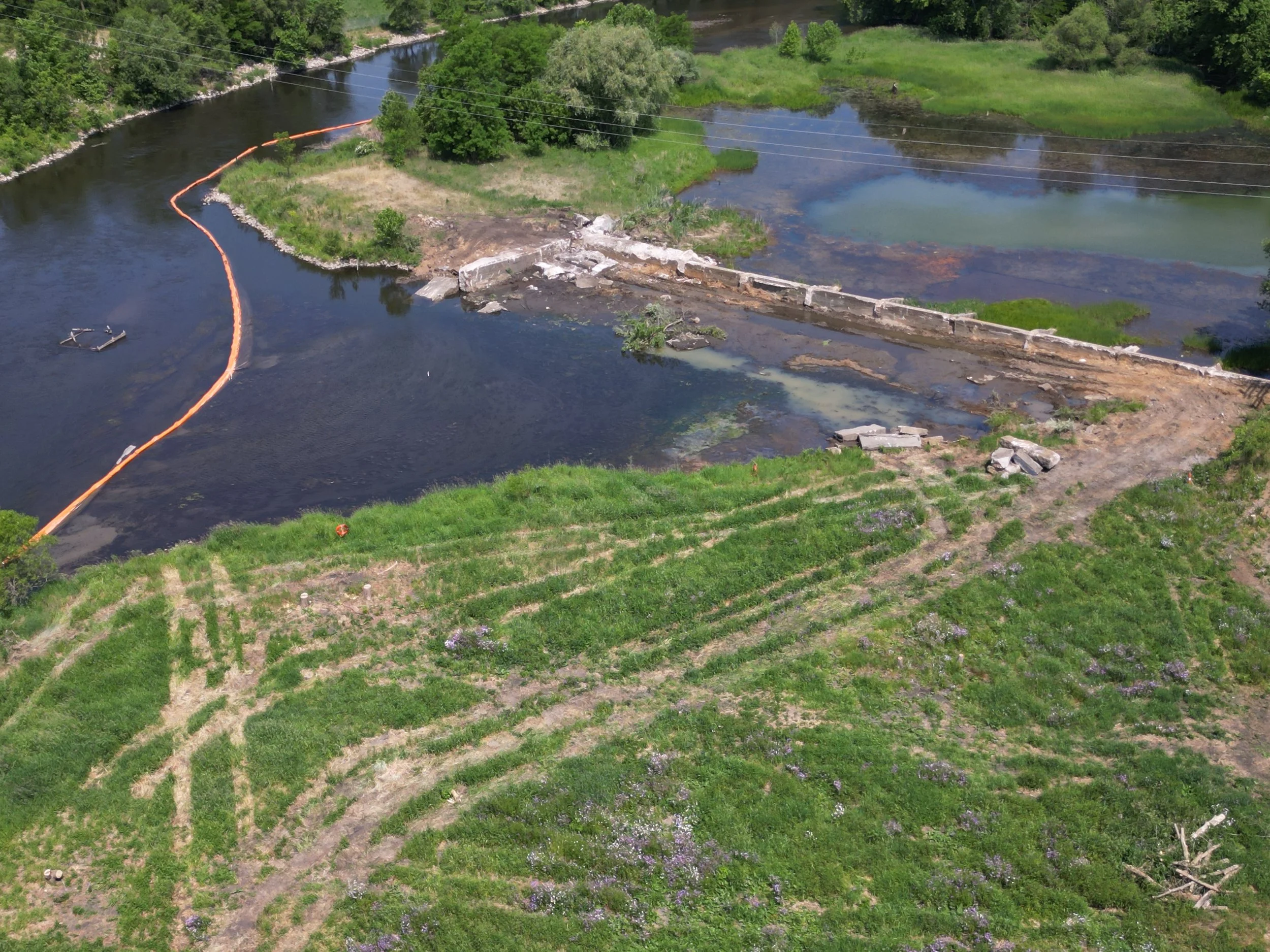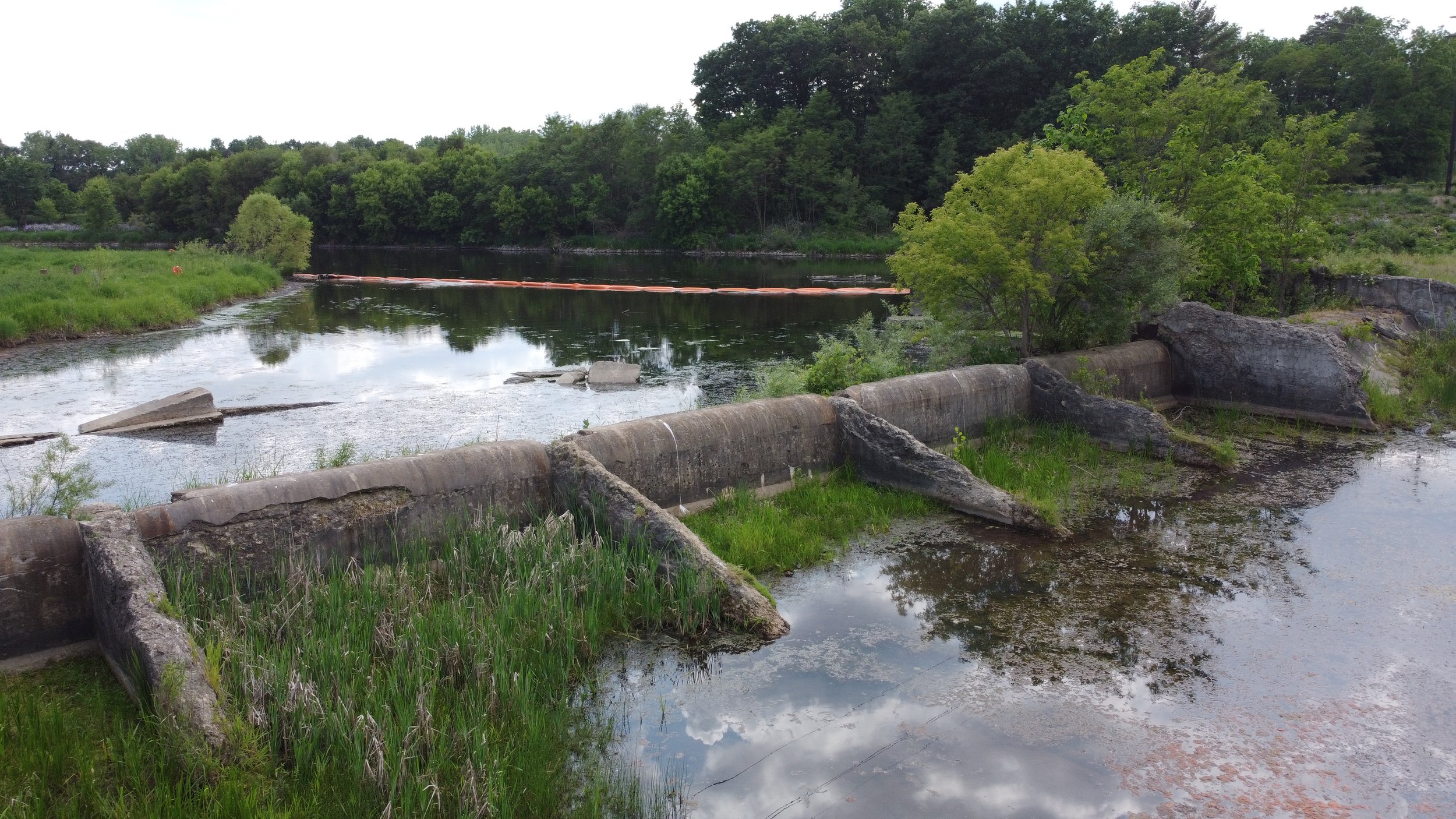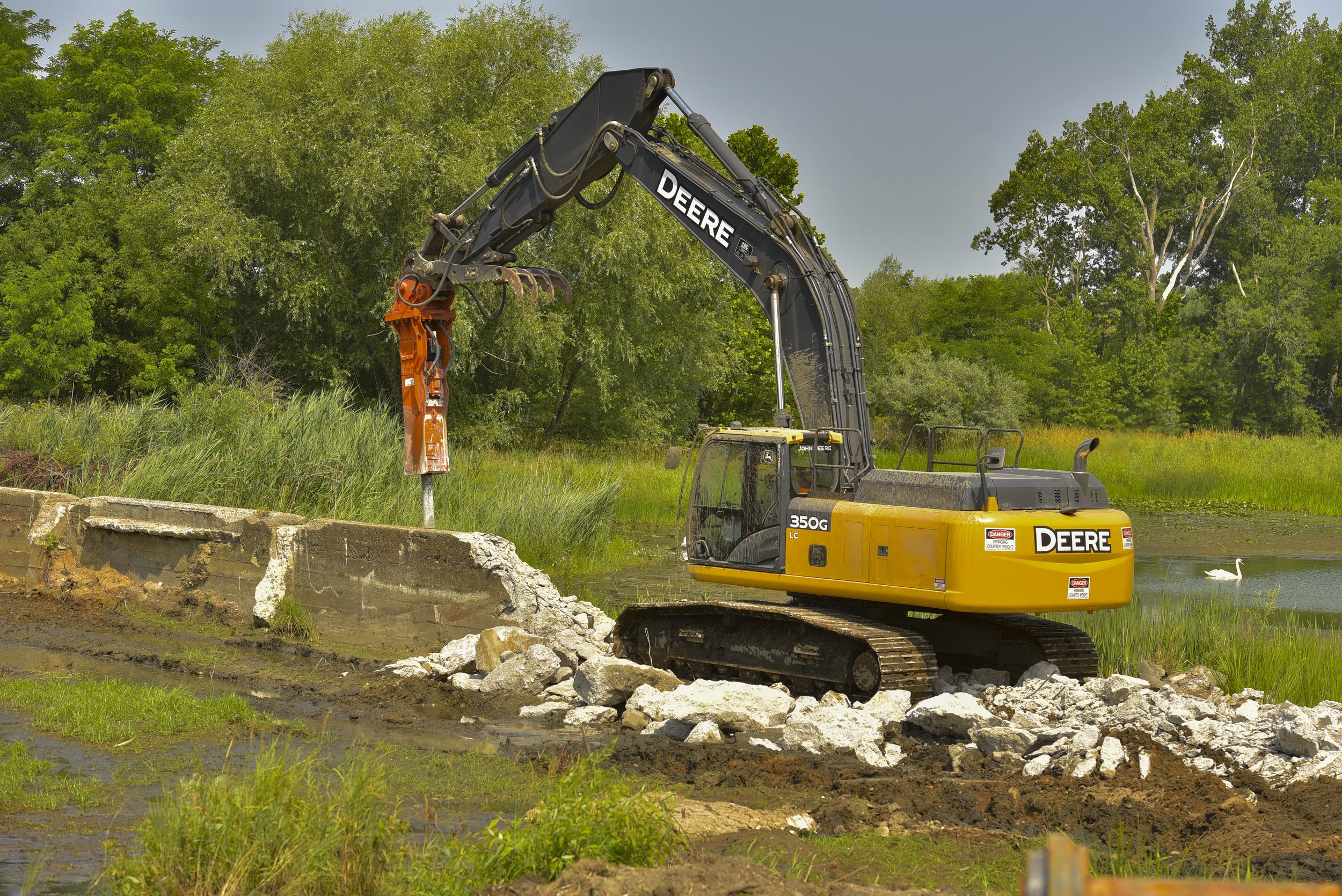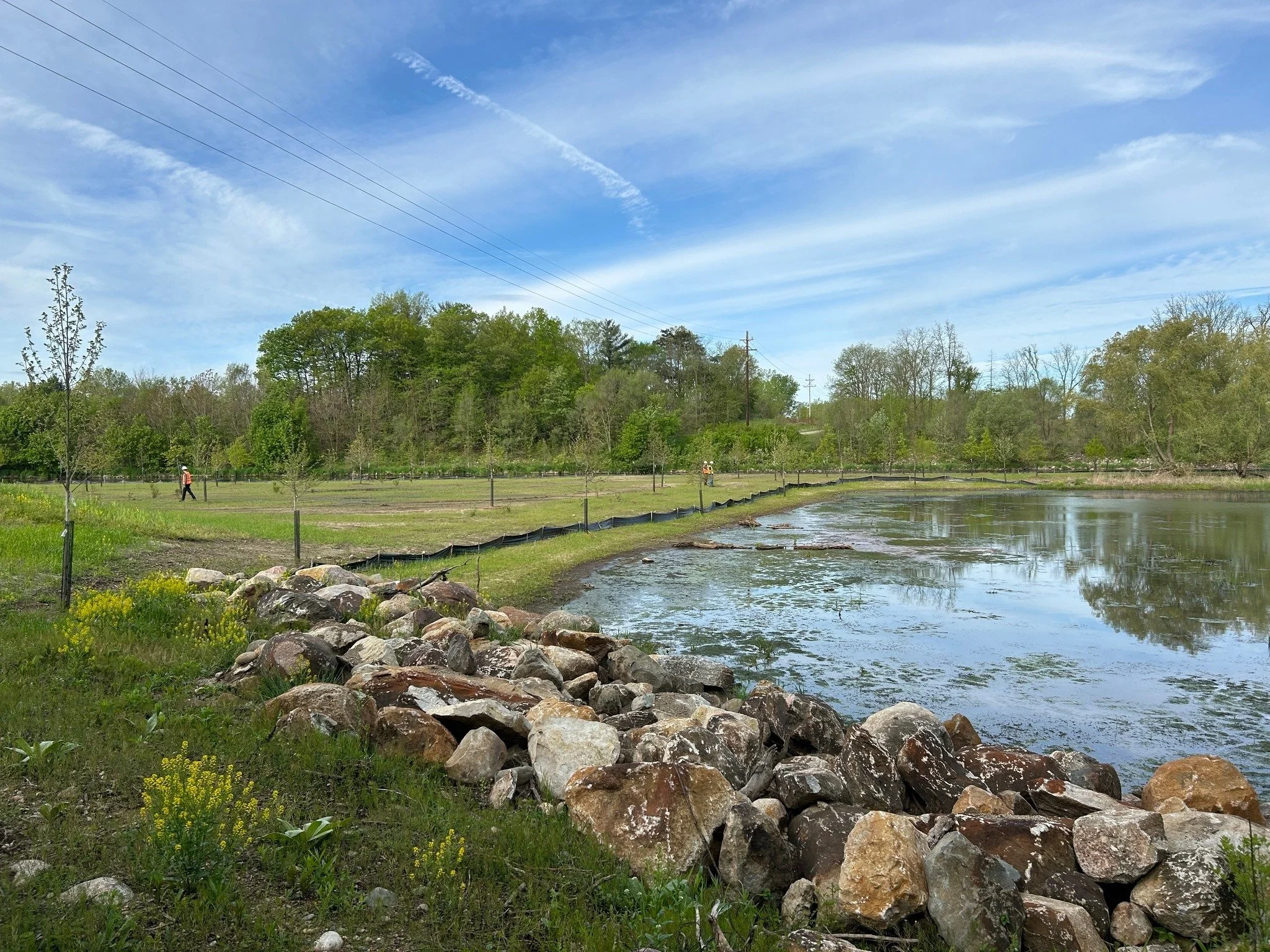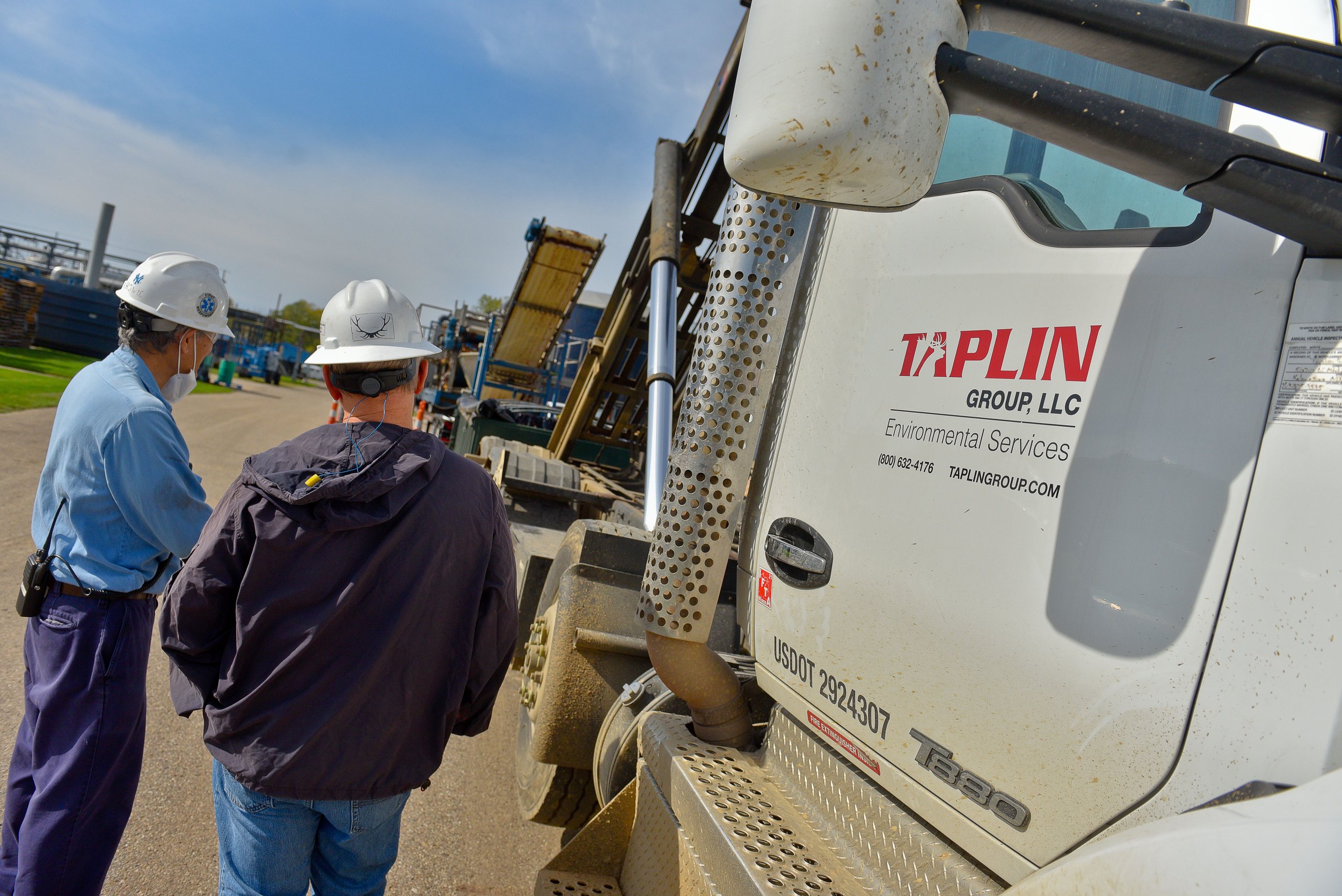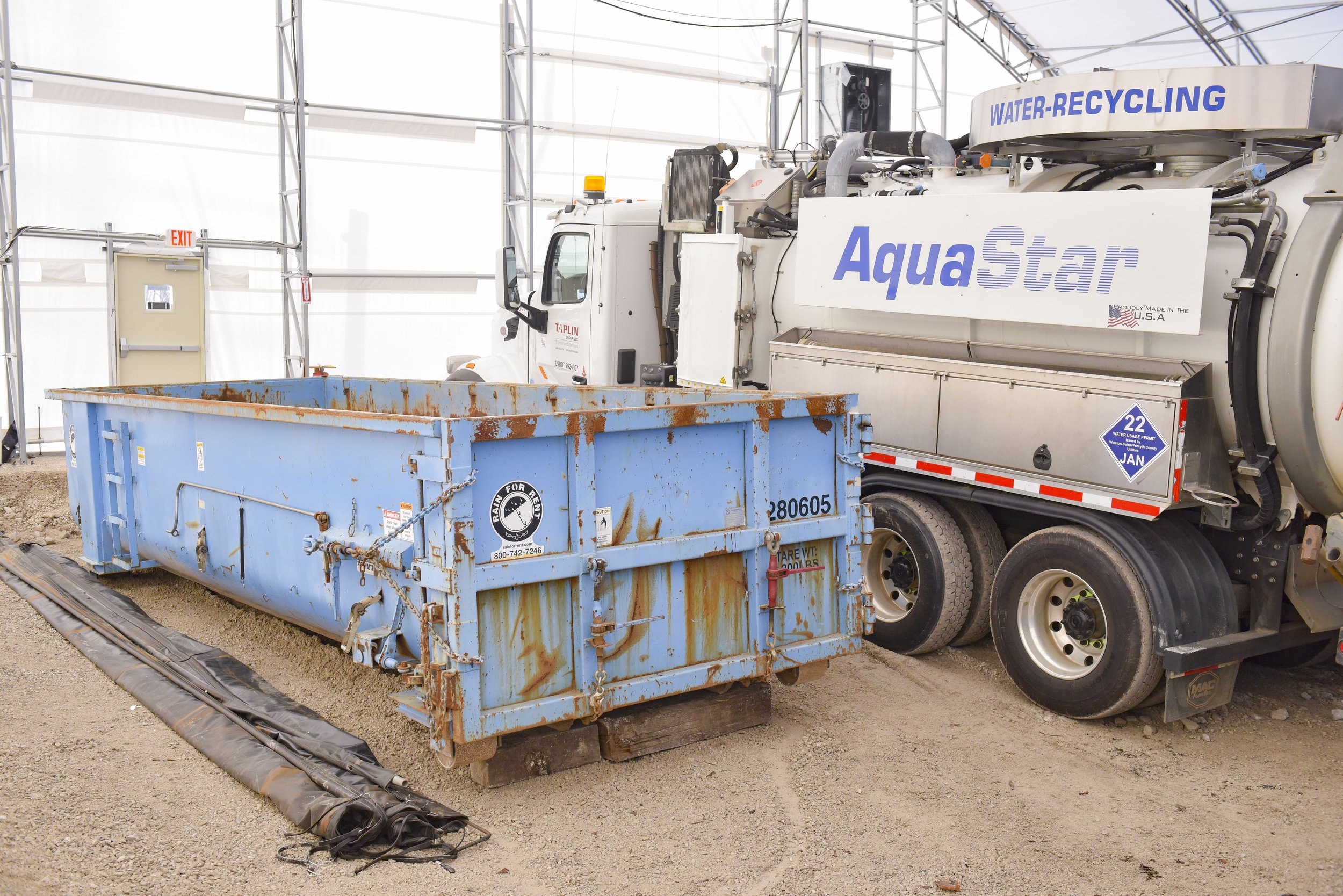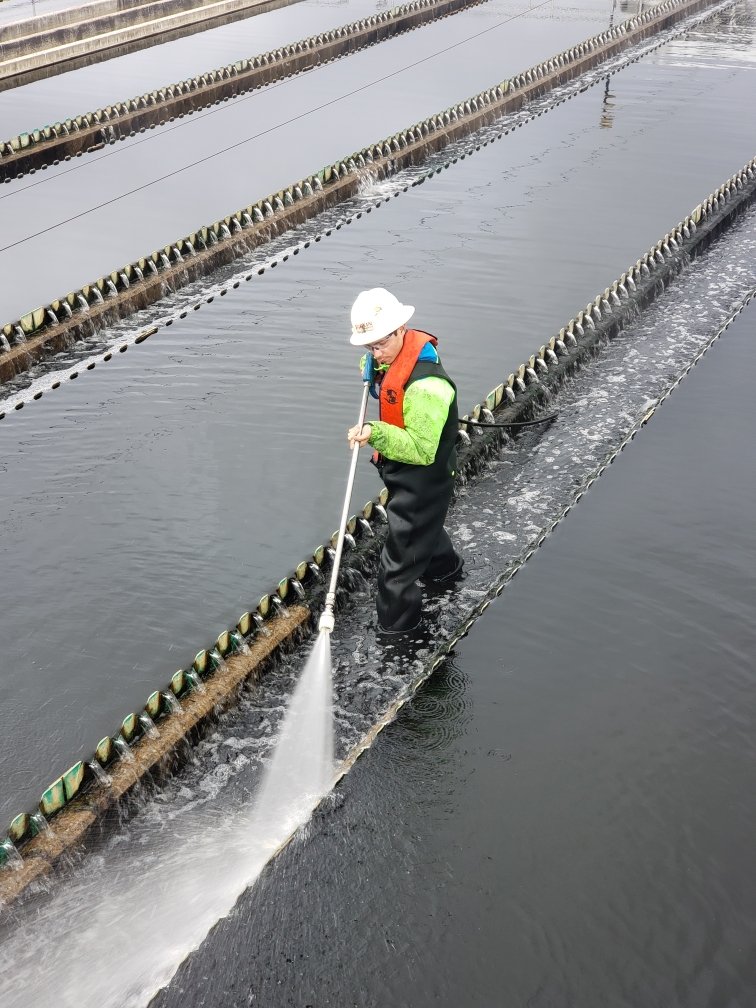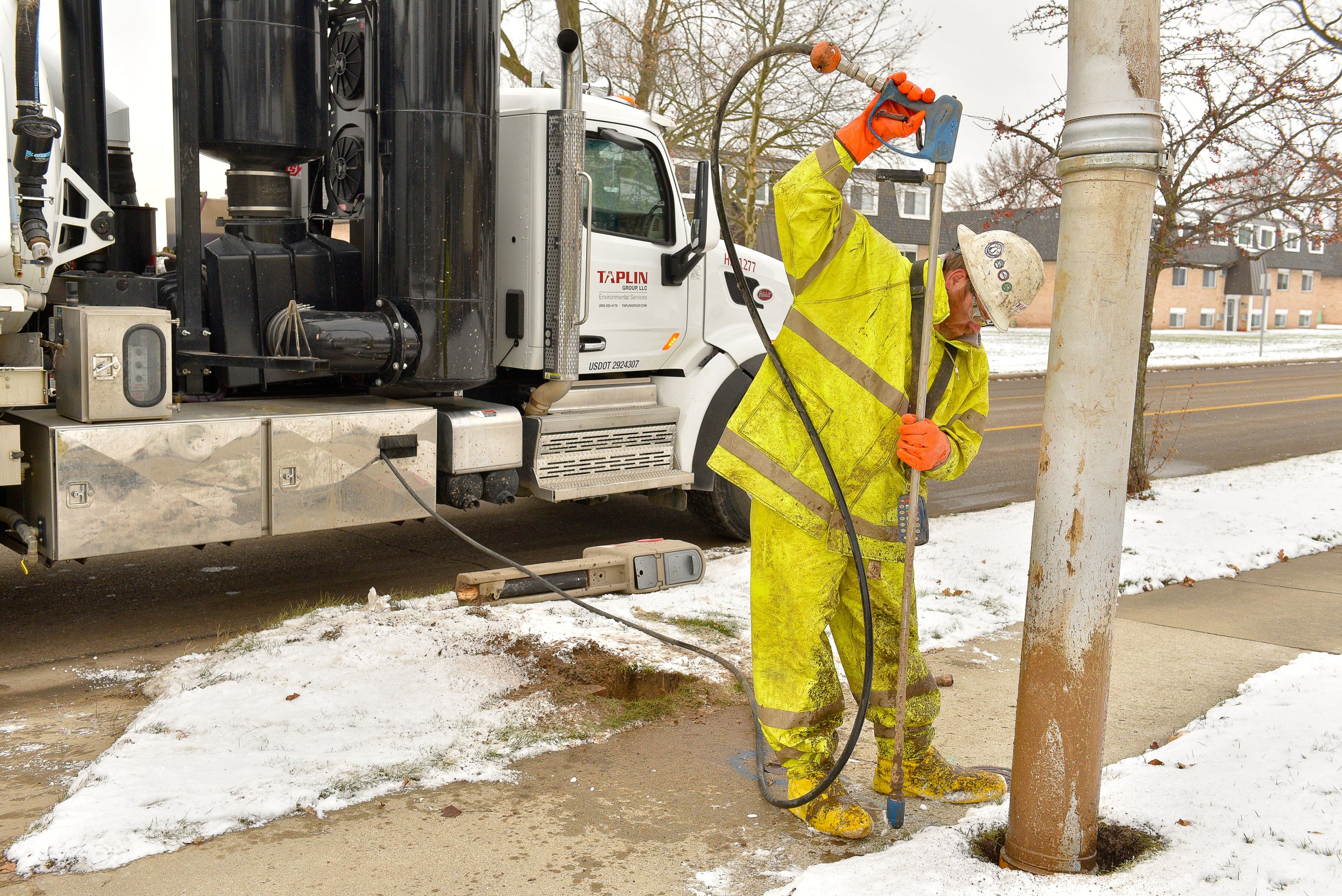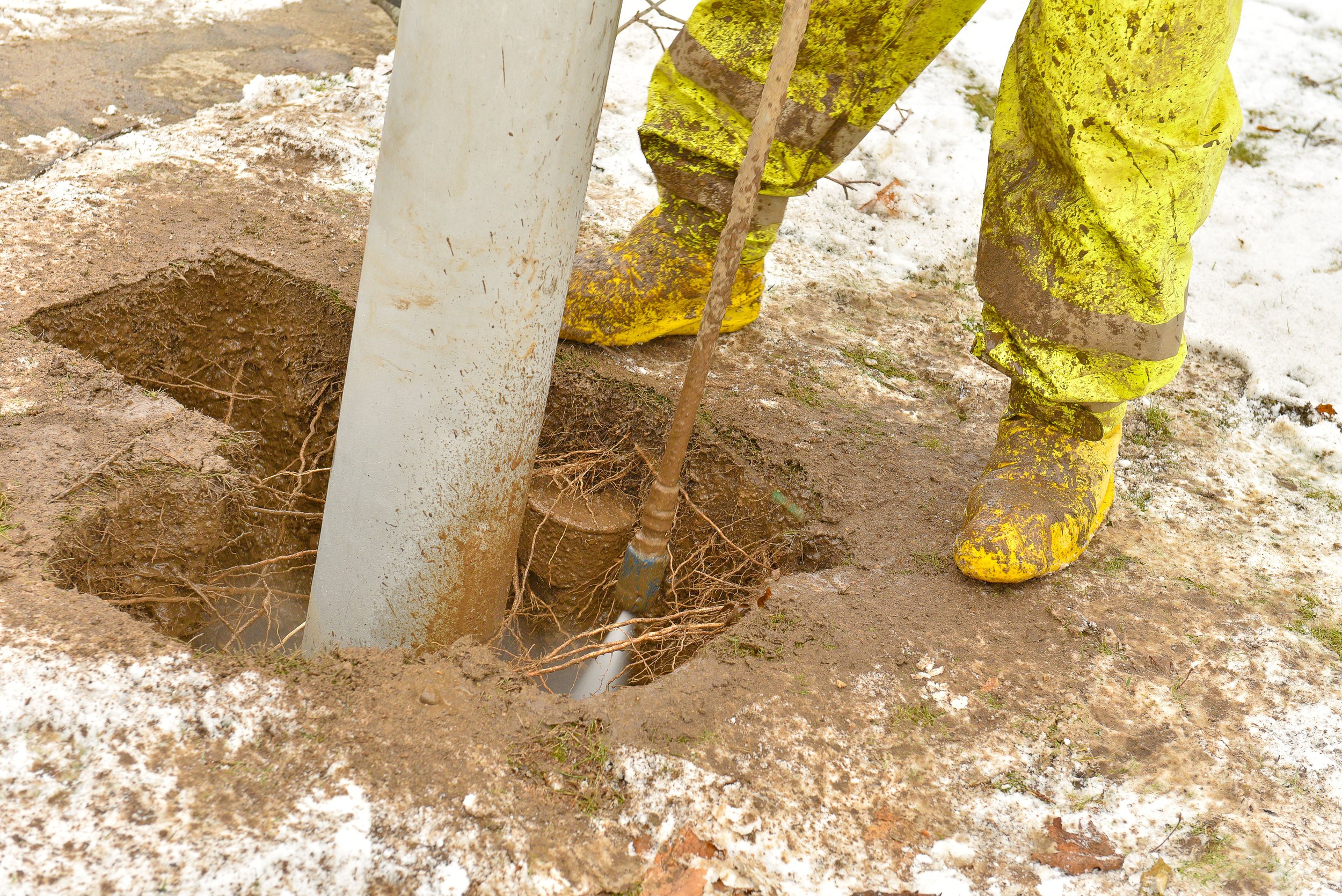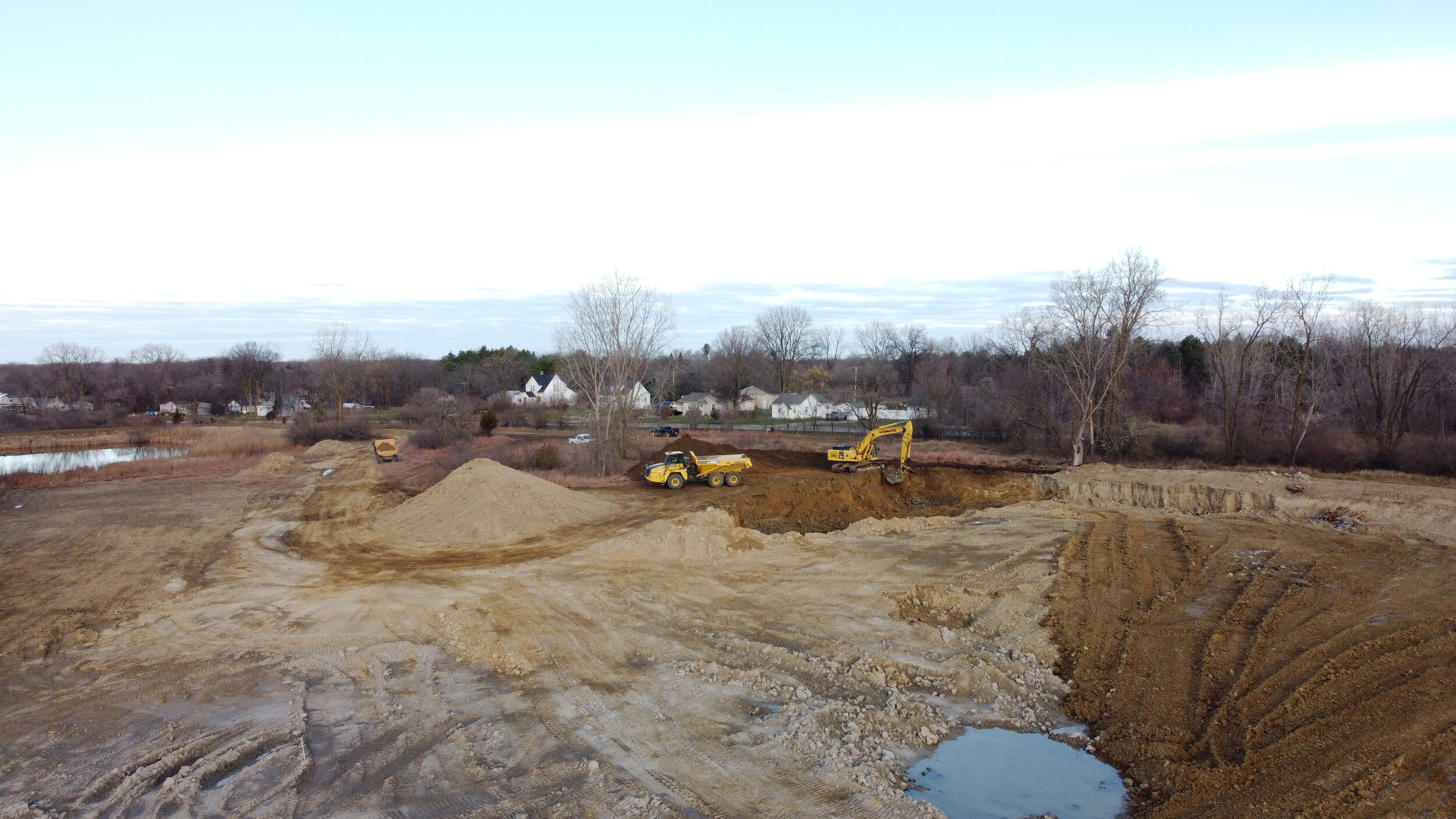Armen Cleaners
Conducted insitu- chemical soil stabilization for VOC contaminants. Taplin was identified to conduct soil stabilization at the Former Armen Dry Cleaners site in Ann Arbor, MI. The project site was broken up into grid patterns and columns; with a total of 18 grids and each grid having 9 columns each.
A Komatsu PC490 excavator was outfitted with an ALLU rotary/mixing head connected to the ALLU pressure cart via large diameter air hoses. The ALLU pressure cart has two large separate dry vessels that was filled with Sodium Persulfate and Portland cement that was controlled by high-volume high-pressure air. The excavator with ALLU head would rotary down into the columns to loosen the soil for the initial pass. The excavator with ALLU head would then rotary down in as a second pass injecting 2,500lbs of the sodium persulfate that was being transferred from the pressure vessel. The third and final pass of the ALLU rotary head was the 1,500lbs Portland Cement. Water was introduced during all three passes to keep the soil and amendments from tightening up during the process. A total of 390,000lbs of Sodium Persulfate and 380tons of Portland Cement was used to complete the project.
Orphan Well Repair and Plugging
Taplin Group and Excel Site Rentals collaborated on one of Michigan’s most complex well-plugging projects this year. Conducted in Ottawa County on a county park’s waters, the project showcased innovative problem-solving, environmental stewardship, and effective teamwork. The initiative was completed ahead of schedule and under budget, demonstrating the power of collaboration in addressing technical and environmental challenges.
Project Details
Location: Offshore in Ottawa County, Michigan, with wells situated 8–12 feet deep in water.
Objective: Safely and efficiently plug two orphan wells in compliance with state environmental standards.
Partnership: Taplin Group provided environmental expertise and equipment, while Excel Site Rentals managed drilling and rig setup.
The project was unique for its location: two wells situated hundreds of feet offshore in water depths ranging from 8 to 12 feet. It required assembling a barge platform large enough to support a workover rig and other heavy equipment. The water environment posed unique challenges. The pipes protruding from the wells were bent, which required straightening before work could proceed. Taplin crews used an excavator on the barge to carefully pull the pipes straight and then verified their integrity with an underwater rover. This submersible drone proved invaluable, allowing the team to inspect the underwater portions of the wells without having divers enter the water.
Results
Efficiency: The project was completed under budget and ahead of schedule, receiving praise from Michigan’s EGLE Orphan Well Unit.
Environmental Success: No spills or safety incidents occurred, reinforcing the team’s commitment to environmental protection. Rigorous environmental safeguards and equipment planning ensured success in a unique water-based operation. Combining expertise and resources between Taplin Group and Excel Site Rentals proved essential to overcoming technical and logistical obstacles. The success of this project has set the stage for continued collaboration. Upcoming joint projects include land-based well-plugging operations, with both companies expressing interest in future water-based challenges.
Macomb County Interceptor Inspection
In early 2023, the Macomb County Public Works Office, acting on behalf of the Macomb Interceptor Drainage District and the Eight & One-Half Mile Relief Drain Drainage District, issued a bid for inspecting their respective systems. This project presented unique challenges, but Taplin approached it with confidence in operational ingenuity and determination to overcome any obstacles.
Eight & One-Half Mile Relief Drain Drainage District
The task at the Eight & One-Half Mile Relief Drain Drainage District involved inspecting a total of 48,557.5 linear feet of pipes, ranging widely in size from 24 inches to an imposing 12 feet in diameter. Safety was paramount, particularly concerning personnel performing entries for equipment setup and transport. The team employed air movers, live air monitoring systems, and specialized air apparatus to safeguard crew working underground. These precautions ensured that the working environment remained safe and compliant with stringent safety standards throughout the inspection process.
One of the most significant challenges encountered during this project was managing haze and particulate matter that often clouded the quality of video inspections in the larger tunnels. Due to the infrequent significant flows in these tunnels, mainly occurring during rainy periods, the air within the tunnels remained stagnant, exacerbating the visual obstruction caused by haze and particulates. To effectively address this challenge, Taplin devised a strategic solution.
By positioning air movers at both upstream and downstream manholes, the crew created a controlled airflow system. This method generated positive and negative pressures, effectively clearing the haze and particulates and significantly improving the quality of the video inspections. This innovative approach not only ensured compliance with inspection requirements but also enhanced the overall efficiency and accuracy of operations.
Macomb Interceptor Drainage District
Meanwhile, in the Macomb Interceptor Drainage District, the scope encompassed inspecting 80,371 linear feet of pipelines. These pipes varied in length from 36 feet to a half-mile, with the longest single segment measuring an impressive 2,143.5 feet. The challenge was managing the flow velocities within these pipes, which posed significant obstacles to inspection efforts. To effectively navigate these challenges, Taplin developed and implemented a specialized continuous tag lining system. This innovative approach allowed the crew to maintain an average daily inspection pace of approximately 2,100 feet. By carefully controlling the speed of inspection, the crew ensured compliance with NAASCO’s stringent standard of maintaining a consistent pace of 30 feet per minute. This system not only optimized efficiency but also enhanced the precision and reliability of inspection outcomes, thereby meeting and exceeding client expectations.
Accessing these pipelines presented another layer of complexity, given the average frame clear openings of approximately 24 inches at access points. This necessitated meticulous planning and coordination to ensure safe and effective equipment deployment and operation within the confined spaces of the pipelines. In some instances, equipment assembly had to be performed inside the pipes themselves, often under challenging conditions. This required team members to utilize harnesses, man-winches, and Personal Rescue Lifts (PRLs) to ensure their safety and facilitate efficient equipment deployment.
Operational challenges extended beyond technical aspects, encompassing logistical complexities associated with working beneath busy thoroughfares like Garfield Road and 15 Mile Road. The need to perform inspections required careful traffic management, including temporary lane closures during nighttime hours on roads with multiple lanes. This strategic approach ensured both the safety of team members and the uninterrupted flow of traffic, demonstrating a commitment to minimizing disruption to the community while executing essential infrastructure maintenance activities.
Moreover, the project overlapped with ongoing rehabilitation, operation, and maintenance contracts within the same vicinity. Coordinating crew activities alongside those of other contractors posed additional logistical challenges. To accommodate the county’s operational needs and ensure the efficient completion of the contract, the team adapted their working hours. This flexibility entailed working extended night shifts, totaling up to 15 hours per shift, to align with the schedules of other contractors and mitigate potential disruptions to pump stations and flow operations.
A critical component of Taplin’s responsibilities involved inspecting and reinstalling gaskets and bolts on a 48-inch force main located off the Clinton Dale Pump Station. This task required sourcing high quality materials from local Michigan manufacturers. The Taplin team devoted significant effort to reviewing as-built plans and collaborating closely with engineering teams to ensure the procurement of gaskets and bolts that met and exceeded industry standards for durability and performance. Prior to installation, thorough cleaning of the access point structures was necessary to remove accumulated sediment from historical leaks and runoff. This proved crucial in ensuring the successful installation and reliable operation of the gaskets and bolts, minimizing the risk of future failures.
Following the completion of the work, Taplin’s comprehensive approach and innovative solutions garnered positive feedback and recognition from Macomb County officials. Their request for specifications regarding our gaskets and bolts served as validation of their satisfaction with our performance and the quality of our materials and workmanship. This acknowledgment underscored Taplin Group’s commitment to excellence and our ability to deliver superior results while overcoming complex challenges with professionalism and efficiency.
In summary, the Macomb County project exemplified Taplin Group’s dedication to innovation, safety, and meticulous planning in tackling multifaceted infrastructure challenges. By leveraging advanced technologies, strategic methodologies, and a proactive approach to problem-solving, we successfully navigated diverse operational environments and delivered exceptional outcomes that met and exceeded client expectations.
Essential ROW Clearing Services for Energy Suppliers and Pipelines
Taplin Group has fostered a longstanding relationship with a major North American natural gas supplier, providing essential Right of Way (ROW) Clearing services. This critical service ensures that the pathways for pipelines remain free from trees, brush, and other obstacles, adhering to federal regulations that mandate clear routes for both aerial and ground inspections. Over the years, Taplin Group has executed numerous ROW clearing operations across various locations in Michigan, spanning state forests, wetlands, and residential areas. The geographical diversity of these projects necessitates a flexible approach, although the core objectives and methodologies of the work remain consistent.
The process of ROW clearing involves the deployment of specialized equipment tailored for efficiency and safety. This includes skid steer mounted fecon units, tractors equipped with brush hogs, chainsaws, chippers, and occasionally boom lifts for addressing larger trees. Each piece of equipment is strategically employed to ensure thorough clearance while minimizing environmental impact. Central to the success of each project is a meticulously planned procedure that begins with marking the pipeline and delineating the boundaries of the ROW. Advanced pipeline locating equipment is used to precisely mark the pipeline’s path, measure the proper distances for ROW boundaries, and outline the edges to guide the fecon operators. This upfront marking process not only ensures compliance with regulatory requirements but also enhances safety and operational efficiency.
Prior to the commencement of clearing operations, Taplin Group’s marking crews conduct thorough surveys of the ROW terrain. This proactive approach helps identify and mitigate potential hazards such as buried steel materials, abandoned vehicles, discarded appliances, and large stones. Addressing these hazards before clearing begins is crucial for maintaining crew safety and preventing equipment damage. Throughout each project, Taplin Group emphasizes comprehensive documentation and reporting. Detailed reports are compiled, documenting cleared segments, providing daily before-and-after photos, and offering narratives that outline the work completed and any encountered challenges. This documentation serves not only as a record of project milestones but also as a tool for evaluating performance and addressing any issues that may arise. Safety remains a top priority throughout every phase of ROW clearing projects. The nature of the work involves navigating rough terrain, managing equipment in adverse weather conditions (often during winter months), safely felling trees, and navigating potential water hazards. Taplin Group’s commitment to safety is reinforced by a rigorous safety program and extensive experience in ROW clearing, which collectively enable them to successfully undertake projects of considerable scale and complexity.
Taplin Group’s expertise in ROW clearing is characterized by a blend of advanced technology, rigorous planning, and a steadfast commitment to safety, exceeding customer expectations and environmental stewardship. Their ability to navigate diverse terrains and regulatory landscapes underscores their capability to deliver effective solutions for maintaining crucial pipeline infrastructure across varied geographical settings.
Kalamazoo District Orphan Well Project: Facility Decommissioning and Site Restoration
The Kalamazoo District Facility Decommissioning and Restoration Project was a State of Michigan Department of Environment, Great Lakes, and Energy (EGLE) endeavor that took place at (6) locations in Oceana and Newago Counties, Michigan. The main purpose of the project was to drain, clean and remove oil storage tanks, flow lines, vessels, containments, concrete pads, and other equipment that have been on these locations for many years, as most of these tank battery locations were part of abandoned wells.
The project began in April 2023 and concluded in August 2023. The (6) site locations were scattered around Oceana and Newago Counties in various areas, mostly rural, agricultural areas. This project was part of federal funding provided by the Department of Interior. During the course of the project, representatives from the Department of Interior visited the sites and were very pleased with the quality of work that Taplin was executing.
When crews arrived on each site, they would remove any fluids left in the tanks and take that material for disposal, clean the tanks and vessels, clean and remove the flow lines and transport all salvageable materials to the salvage yard, which included steel flow lines, tanks, and vessels. For at least (3) of the locations, Taplin was required to solidify the material removed from the tanks, prior to disposal. Once the tanks etc. were removed, any impacted soil would be excavated and transported for disposal. Finally, the locations would be restored and seeded in a way that most would have no idea that a tank battery was ever there.
The Taplin crew was made up of a Superintendent, (2) operators and (1) laborer. Roll off drivers and a fill in tanker driver were used intermittently. An excavator with a thumb attachment, skid steer, mini-excavator, tractor, low boy and stainless steel tanker were on-site for all operations to complete the work.
Impacted Soil Remediation
The purpose of this project was to remediate impacted soil from the former operation of a chemical company located in west Michigan.
The 5-acre site was a bulk chemical transfer and repackaging plant from 1952 to 1991. Prior to 1963, the company discharged its wastewater into the ground. Chemical spillage and leaks from underground storage tanks also contributed to soil and groundwater contamination.
The soil and groundwater are contaminated with metals and several organic compounds including polycyclic aromatic hydrocarbons (PAH), ethylbenzene, toluene, benzene, and xylene. In 1981, residential wells near the site were found to be contaminated with volatile organic compounds (VOCs). In 1983, the site was declared a superfund.
The project highlights included:
• Demolishing abandoned buildings and sheds on the project site.• Excavation, transportation and disposal of nearly 69,000 tons of impacted soil.• Conducted regular odor (VOC) control measures to prevent fugitive odors on adjacent residential properties.• Provided temporary excavation support around the perimeter allowing vertical excavation walls to a depth up to 20 feet below ground level.• Backfilled excavation with approximately 52,000 cubic yards of clean sand backfill.• Placed and mixed 750 tons of Bio-Absorbent Media (BAM) in the bottom two feet of the excavation to absorb and remediate remnant VOC’s from the underlying groundwater.• Removed multiple unanticipated obstructions to work including purge and monitoring wells and abandoned underground storage tanks. Of particular importance was preventing disruption to the adjacent school and residential properties near the site. Once all excavation was complete and backfilled with sand, a layer of topsoil was placed and graded to provide appropriate coverage for hydroseeding. Despite multiple delays at the beginning of the project while waiting for the local utility disconnects, the project was completed ahead of schedule and under budget.
Emergency Oil Spill Response
On April 13, 2023, the State of Michigan’s Environmental, Great Lakes and Energy Division contacted Taplin Group regarding a oil sheen discovered in a man-made lake that was adjacent to the Grand River in Jenison, Michigan.
In the days leading up to the 13th, the area sustained heavy rains, which caused the Grand River to overflow its banks into the manmade lake, raising to an abnormally high level which then flooded inland.
This increased lake level, impacted (3) plugged oil wells that were in shallow areas near the natural shoreline until the lake levels rose. High levels allowed water to enter the well station pipes. This normally would not be an issue, but the well owners did not plug the wells properly. As a result, the inflow of water caused the wells to “burp” oil and discharge into the lake. It was estimated to be approximately 2000-5000 gallons of oil entered the lake. This combined with the rapidly rising waters, allowed the oil sheen to traverse a large area of upland, impacting nearby woods and a lower marsh area.
Within a day of the lake level cresting, it receded leaving behind a large, impacted area.
The Taplin Group was contracted by the State of Michigan to first contain the area around the wells to prevent any future spill outs. Following the well containment, Taplin disbursed approximately 1,600 LF of oil boom to contain the oil coming off the shoreline as the waters receded to prevent further spread into the lake.
Once all the containment efforts were complete, the skimming of the water to remove the oil sheen started. Simultaneously to the skimming efforts, Taplin began excavating impacted soils at the shoreline per EGLE’s direction. As the efforts continued, the State and Local Officials discovered that the oil sheen went further inland than originally thought.
This new discovery required Taplin to respond with additional personnel, excavating equipment and absorbents to clean up trees and excavate impacted soils further inland, including the marsh area.
The initial response, containment and remedial clean up was completed by 4/29. Resulting in 8,000 gallons of liquid disposal, 120 tons of impacted soil disposal, and 3,000 linear feet of absorbent boom deployed.
100% of this was completed by Taplin Personnel and Taplin owned equipment.
Plainwell Dam Spillway Removal and Channel Restoration
Taplin was contracted to perform the removal of a former hydroelectric dam spillway and remediation of PCB contaminated sediment with shoreline restoration along the Kalamazoo River. The site previously housed a 1903 hydroelectric dam and had been declared part of the Kalamazoo River superfund site as a result of legacy contaminants from area papermills and turn-of-the-century manufacturing.
Taplin removed the remaining concrete spillway, excavated sediment down to target elevations and transported/disposed of contaminants while widening the river and reestablishing floodplain benches, constructed wood habitat structures and channel bar features and will restore the shoreline area with seeding and plants. The area spans nearly 7 acres of wetlands and the project was completed in 2024/2025.
Read the State of Michigan project completion announcement here.
Hydro-Blast Plant Cleaning and Waste Hauling
Taplin Group was contracted to provide hydro-blasting cleaning services to a chemical manufacturing plant in South Haven, MI. Taplin crews efficiently pumped the 360,000-gallon digester and filter pressed solids. The digester walls and floor were hydro-blasted for inspection and repairs. Crews then provided transport and disposal of the filter cake and waste materials. Once the digester was finished, crews moved on to cleaning one of the plants 600,000-gallon single batch reactors that is also part of the waste treatment system. The reactor was in need of inspection and repair that would have been impossible without the initial cleanout provided by Taplin.
Wetland Mitigation
A muck field previously drained to accommodate agriculture is being modified to create two wetland cells covering approximately 24 acres. Taplin is constructed a dual cell wetland from previously drained muck fields. The area was cleared prior to construction. GPS controlled equipment was utilized to ensure compliance with designated elevations and contours. The project featured constructed berms and two separate cells and two installed agri-drain level control structures.
Former Papermill and Landfill Superfund Site
PCB contaminated soil and landfill site remediation to construct geotechnically stable slopes for a geosynthetic soil cap to be placed over the waste.
The original papermill was constructed in the 1890’s. The former landfill site is approximately 71 acres. Paper residuals were deposited throughout the site. PCB’s were first manufactured in 1929 and continued until they were banned in 1979. Non-carbon paper once contained PCB’s. When the non-carbon paper came back to the papermills for recycling, the PCB’s found their way into the effluent from the mills. Contaminated paper residuals were then placed in the landfill. The residuals were pumped from the papermill to the landfill and deposited in various lagoons. Although over time the residuals dewater somewhat, they remain high in moisture. This moisture precludes them from being able to bear load.
The primary purpose of the project is to consolidate wastes from around the site and pull the limits of said waste back from the creek. The goal is to construct a landfill that possesses geotechnically stable slopes whereby a geosynthetic and soil cap can be placed over the waste.
Site restoration construction will include:
• Removal of all steel sheet piling along creek
• Restoration of a meandering stream bed for creek
• Creek bank enhancements and in stream riffles
• Restoration of a wetland alongside creek
During the early stages of the project, it became known that the moisture content of the paper residuals was very high. Even mixing the paper residuals with granular soil would not yield a product that could meet the strength requirements to construct the slopes of the landfill. Taplin proposed the use of a pugmill in order to amend the paper residuals with a dry, cementitious powder. Paper residuals delivered to the pugmill location would be loaded into the pugmill mixing chamber, through a hydraulic grizzly screen, utilizing an excavator. Silos containing the dry, cementitious powder convey their content into the mixing chamber. Within the mixing chamber, twin mixers combine the wet paper residuals with the dry powder to manufacture a structurally competent material. Prior to the amendment process the off-road dump trucks could not traverse the paper residuals mixed with granular soils without leaving 2’ deep ruts. Once the amendment process was introduced, the trucks could traverse over the paper residuals with minimal indentation.
In addition to the pugmill, Taplin purchased an Allu mixer to stabilize the paper residuals in situ. The goal was to utilize both the pugmill and the Allu to increase production and reduce project schedule. Although field testing operations produced a product that was suitable for placement, the process was not initiated. The Allu, combined with the GPS technology on the excavator, is able to distribute a prescribed amount of amendment to a given area in order to be as precise as possible in delivery.
Milwaukee Metropolitan Sewerage District PCB Remediation
The primary focus of this project is to remove approximately 485 cubic yards of PCB impacted sediment from 1.5 miles of 60”-72” interceptor sewer within the city limits of Glendale and Milwaukee. The PCB’s originated from a former superfund site that went through a cleanup back in the early 2000’s.
The scope includes the site development for an area identified as NS3, which will be home to a 100,000 gallon per day treatment facility. All wash water from the cleaning operations and the solidification of the impacted sediment will be treated with this system before reintroducing the water to the interceptor system. This entire solidification and treatment system will be housed under a 125’ long by 75’ wide sprung structure.
Once the treatment system is in place, our cleaning operations will commence, utilizing one of our expert Large Diameter Sewer Cleaning teams. With a high flow system capable of delivery up to 250 GPM at 2500 PSI. Operations are set to start at the end of October 2022.
Former Resort Demolition and Property Remediation
Taplin Enterprises was subcontracted to perform property demolition of a former ski resort in Northern Michigan. The property sat abandoned for more than 20 years and was in complete disrepair and included numerous buildings and structures, all of which had to be removed and the property returned to a natural state.
San Antonio Water System Contract
Taplin Group has partnered with SAWS for several years worth of contract work in the City of San Antonio. The extensive contract has spanned regular maintenance, emergency service work as well as long-term infrastructure upgrades. We are honored to continue to serve and work with the San Antonio Water System.
Hydro Excavation for Municipal Utilities
Taplin Group provided hydro excavation work for approximately 650 services throughout a mid-Michigan city. This work was required for compliance with the revised lead and copper rules issued by the Michigan Department of Environment, Great Lakes, and Energy (EGLE) as part of a state water grant the city utilized. The mandated Water Service Material Investigation required the City identify the materials of water services on both sides of the shutoff box at the right-of-way. Taplin performed the work with no interruption of services to residents.
Crews worked to locate the water service line and other underground utilities and then utilized a hydro excavation truck to make two small holes on either side of the shutoff. The holes were then filled once the testing work was complete.
Paper Plant Tank Cleanout
A paper manufacturing plant required emptying of the by-product paper sludge from their waste holding tanks. Crews utilized a vacuum truck and articulating boom lift with a long reach excavator to remove floating fibers from the 471 cubic yard clarifier tank. Crews took precautions to ensure the protection of the surrounding environment as they removed excess water from the waste in preparation for transport. The dewatered waste material was then transported to an appropriate facility.
Municipal Wellfield Superfund
Manufacturing site soil contamination cleanup and underground remediation system.
The primary objective of this project was to install a Soil Vapor Extraction / Air Sparge System. Achieving this objective required the earthwork to provide a proper subgrade for the remedial systems; the construction of underground vaults including necessary valves, temperature gauges, vacuum gauges and pressure gauges; the installation of new piping, including trenching and tie-ins to existing piping; the construction of a concrete foundation for the pre-fabricated treatment building and the connection of subsurface piping to above ground piping; and electrical installation. Once piping was installed, trenches were backfilled and a concrete pad with access manhole was constructed before the site was graded and hydroseeded to restore pre-work conditions.
Multi-Phase Industrial Cleaning at Manufacturing Plant
An ethanol producer required a major cleanup of their manufacturing plant within a 24-hour period. This project required multiple tasks to be completed within an extremely tight timeline. The tasks involved included cleaning eight evaporators, cleaning multiple syrup lines, vacuum dust from a silo and scalper bin and cleaning a 35,000 gallon corn oil storage tank and sludge line.
The team assigned multiple crews and necessary project support to successfully complete the shutdown projects. The 35,000 gallon corn oil storage tank was cleaned after the syrup lines were cleaned. The tank was drained to within 8-feet of the bottom and crews pumped down the remaining material and discharged the waste water into a pit. Once the tank was empty, crews utilized non-entry tank cleaning tools and technology to clean the inside of the tank. Once the inside of the tank was cleaned the 1” sludge line leading to the CIP tank was cleaned.
Storm Water Management Improvements and Contaminated Soil Erosion Control
Storm water management improvement plan and contaminated soil erosion control. This project consisted of approximately 117 acres, including a closed former hazardous waste landfill.
Taplin implemented soil erosion controls to prevent the migration of sediment and contaminants from the areas throughout the project. Water was diverted as needed and permanent control measures were implemented for long-term stabilization and containment.
Gordie Howe Bridge Pre-Construction Environmental Cleanup
Removal of Universal Waste and Contaminated Soils at various locations within the construction zone of the newest Detroit River crossing; The Gordie Howe International Bridge.
The Gordie Howe International Bridge is the newest Detroit River crossing to be built. In preparation for the build and prior to construction, Michigan’s Department of Transportation had to acquire multiple properties for the bridge’s footprint. Some of the properties had existing structures on site and others had legacy contamination from the former occupants.
The Taplin Companies successfully completed the removal and disposal of Universal Waste of existing structures in preparation for demolition. Additionally, Taplin removed contaminated soils in various former manufacturing properties along the Detroit River. Those contaminants included: Asbestos, Arsenic, Barium, Cadmium, Chromium, Lead, Silver, PCB, and Trichloroethylene. In total, 28,565 tons of contaminated soils were removed from the sites.
In addition to the cleanup, the Taplin Companies were contracted to conduct the exposure of tie-backs of the river’s seawall. That involved the removal of those same contaminants comingled with heavy demolition debris all without damaging the tie-backs themselves and making the excavations safe for engineers to conduct condition assessments and measurements moving forward.
As with all historical manufacturing sites, the unknown is the probable factor. Whether it is discovering undocumented buried structures or utilities, different contaminants or buried drums, the professional Taplin Team in conjunction with consulting engineers were able to safely address the situation. The waste demolition and remediation of the sites laid integral groundwork to pave the way for the eventual construction of the bridge.












































